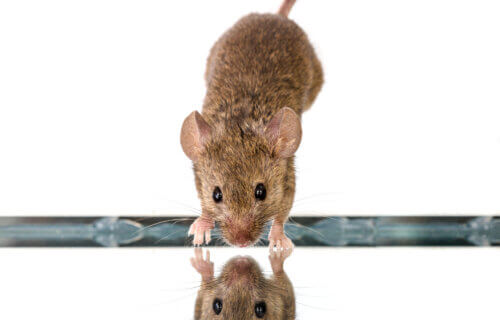DALLAS — Can mice see themselves in the mirror? If this question has been eating away at you, good news — a new study finally answers this all-important question. Scientists at the University of Texas report mice indeed display behavior that at least resembles self-recognition upon seeing themselves in the mirror.
When the research team marked the foreheads of black-furred mice with a spot of white ink, the rodents spent more time grooming their heads in front of the mirror. Presumably, to try and get rid of the ink spot. However, it’s also key to note that the mice only displayed this self-recognition-like behavior if they were already accustomed to mirrors, if they had socialized with other mice who looked like them, and if the ink spot was relatively large.
Moreover, study authors even identified a specific subset of neurons in the hippocampus involved in the development and storage of this visual self-image. This work provides the first-ever glimpse into the neural mechanisms behind self-recognition, a topic that has been woefully understudied in neurobehavioral research.
“To form episodic memory, for example, of events in our daily life, brains form and store information about where, what, when, and who, and the most important component is self-information or status,” says neuroscientist and senior author Takashi Kitamura of University of Texas Southwestern Medical Center, in a media release. “Researchers usually examine how the brain encodes or recognizes others, but the self-information aspect is unclear.”
How scientists could tell if mice recognized themselves in the mirror
Researchers made use of a mirror test to investigate if mice could detect a change in their own appearance. In this case, a dollop of ink on their foreheads was used. Since the ink also provided a tactile stimulus, researchers tested the black-furred mice with both black and white ink. While the mirror test was originally developed to test consciousness in other species, researchers note their work only shows that mice can detect a change in their own appearance. This finding alone does not necessarily mean that they are “self-aware.”
So, the mice were indeed capable of detecting changes in their appearance, but only under certain conditions. Rodents especially familiar with mirrors spent significantly more time grooming their heads (but not other parts of their bodies) in front of the mirror when they were marked with white ink measuring 0.6 cm2 or 2 cm2. But, the rodents did not act in the same way when the ink was black—the same color as their fur—or when the ink mark was small (0.2 cm2). Even if the ink used was white, mice who were not used to mirrors before the ink test failed to display increased head grooming in any scenario.
“The mice required significant external sensory cues to pass the mirror test—we have to put a lot of ink on their heads, and then the tactile stimulus coming from the ink somehow enables the animal to detect the ink on their heads via a mirror reflection,” adds first author Jun Yokose of University of Texas Southwestern Medical Center. “Chimps and humans don’t need any of that extra sensory stimulus.”

Via the use of gene expression mapping, study authors were able to identify a subset of neurons in the ventral hippocampus that activated in response to the mice “recognizing” themselves in the mirror. When these neurons were selectively rendered non-functional, the mice no longer displayed the mirror-and-ink-induced grooming behavior. A portion of these self-responding neurons also activated in response to the rodents seeing other mice of the same strain (and therefore similar physical appearance and fur color), but not when they saw a different strain of mouse that had white fur.
Since earlier studies involving chimpanzees indicate social experience is required for mirror self-recognition, researchers were sure to also test mice who had been socially isolated after weaning. Those socially isolated mice did not show increased head grooming behavior during the ink test, nor did black-furred mice that were reared alongside white-furred mice. The gene expression analysis ultimately revealed that socially isolated mice did not develop self-responding neuron activity in the hippocampus, and neither did the black-furred mice reared by white-furred mice. All of this indicates, researchers say, that mice require social experiences alongside other similar-looking mice in order to develop the neural circuits needed for self-recognition.
“A subset of these self-responding neurons was also reactivated when we exposed the mice to other individuals of the same strain,” Kitamura adds. “This is consistent with previous human literature that showed that some hippocampal cells fire not only when the person is looking at themselves, but also when they look at familiar people like a parent.”
Future research
Moving forward, study authors want to try disentangling the importance of visual and tactile stimuli in order to test if mice can recognize changes in their reflection in the absence of a tactile stimulus. This could be accomplished by using technology similar to the filters on social media apps that allow people to give themselves puppy-dog faces or bunny ears, for example. Researchers also plan to study other brain regions potentially involved in self-recognition and investigate how different neural regions communicate and integrate information.
“Now that we have this mouse model, we can manipulate or monitor neural activity to comprehensively investigate the neural circuit mechanisms behind how self-recognition-like behavior is induced in mice,” Yokose concludes.
The study is published in Neuron.
